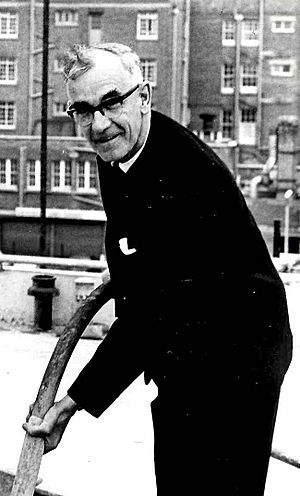Gordon Sutherland facts for kids
Quick facts for kids
Sir Gordon Sutherland
|
|
|---|---|

Sir Gordon Sutherland, September 1965
|
|
| Born |
Gordon Brims Black McIvor Sutherland
8 April 1907 Watten, Highland, Scotland
|
| Died | 27 June 1980 (aged 73) Little Shelford, Cambridgeshire, England
|
| Resting place | Church of All Saints, Little Shelford |
| Education | Morgan Academy |
| Alma mater | University of St Andrews |
| Spouse(s) | Gunborg Elisabeth Wahlström |
| Children | Ann Birgitta Kerstin E Mary Seaton |
| Scientific career | |
| Institutions |
|
Sir Gordon Brims Black McIvor Sutherland (8 April 1907 – 27 June 1980) was an important Scottish physicist. A physicist is a scientist who studies how the universe works, from tiny particles to giant galaxies. He was also a Fellow of the Royal Society, which is a special honor for top scientists.
Contents
Early Life and Education
Gordon Sutherland was born on April 8, 1907, in Watten, Scotland. He was the youngest of seven children. Both his parents, Peter and Eliza, were teachers. They taught him at home until he was ten years old.
After that, he went to Leven Academy for a year. Then he moved to Morgan Academy in Dundee for six years. He was a very bright student.
Gordon then went to the University of St Andrews. He did something very unusual there. He studied for two degrees at the same time! He earned an MA in mathematics and a BSc in physics. This took him five years, and he graduated with top honors in both subjects.
Starting His Research Career
After university, Gordon began his research at Trinity College, Cambridge. He first tried theoretical physics, which uses math to explain how things work. But he soon realized he preferred experimental physics. This involves doing experiments to test ideas.
He switched to studying Raman spectra with other scientists. This is a way to learn about the structure of molecules using light. While working there, he met David M. Dennison, a professor from the University of Michigan in the USA.
Gordon was very impressed by Dennison. He applied for a special scholarship called a Commonwealth Fund Fellowship. In September 1931, he sailed to Ann Arbor, USA. There, he worked with Dennison's team for two years. They used infrared light to study gases like NO2 and N2O4.
Return to Cambridge and War Work
After his time in the USA, Gordon returned to Cambridge, England. He continued his research, solving puzzles about how certain molecules behaved. He became a Staff Fellow at Pembroke College. He soon built his own research group with talented scientists.
When World War II started in 1939, Gordon used his science skills to help. At first, he helped find and disable unexploded bombs. Later, he used infrared spectroscopy to analyze the fuel used by German planes.
He discovered that a part of the fuel, called iso-octane, had a special pattern when viewed with infrared light. This allowed them to quickly identify the fuel. This information was very helpful for the British Bomber Command in choosing their targets.
Leadership Roles and Honors
In 1949, Gordon Sutherland was made a Fellow of the Royal Society. This is a very high honor for scientists in the UK. In the same year, he was asked to become a full professor back at the University of Michigan. After thinking carefully, he accepted the offer. He spent time building up his research group there. He became very interested in how infrared spectroscopy could be used in biology and medicine.
In 1956, Gordon returned to Britain. He became the Director of the National Physical Laboratory (NPL). The NPL is a very important place where scientists work on measurements and standards. He worked hard to get more staff and better equipment for the NPL. He even brought in famous scientists like John Pople to start new physics research.
Gordon Sutherland was knighted in 1960, which means he received the title "Sir." In 1964, he returned to Cambridge again. This time, he became the Master of Emmanuel, one of the colleges at the university. He retired in 1977.
Family Life
Gordon Sutherland met his future wife, Gunborg Elisabeth Wahlström, in Cambridge in 1933. She was from Sweden. They got engaged in 1935 and married in London in 1936.
Gordon and Gunborg had three daughters:
- Ann Birgitta (born 1937) studied art history and became a professor in New York.
- Kerstin (born 1940) worked in research laboratories at the UCLA for 34 years.
- Mary Seaton (born 1943) worked in arts administration.
Sir Gordon Sutherland passed away on June 27, 1980, in Little Shelford, England. He is buried in the churchyard there. His wife, Lady Gunborg Sutherland, passed away in 2001 and is buried with him.
Other Important Roles
Sir Gordon Sutherland held many other important positions during his life, including:
- Member of a Royal Society trip to China (1962)
- Vice-President of the Royal Society (1962-1963)
- President of the Institute of Physics (1964-1966)
- Trustee of the National Gallery (1971-1978), which is a famous art museum.

